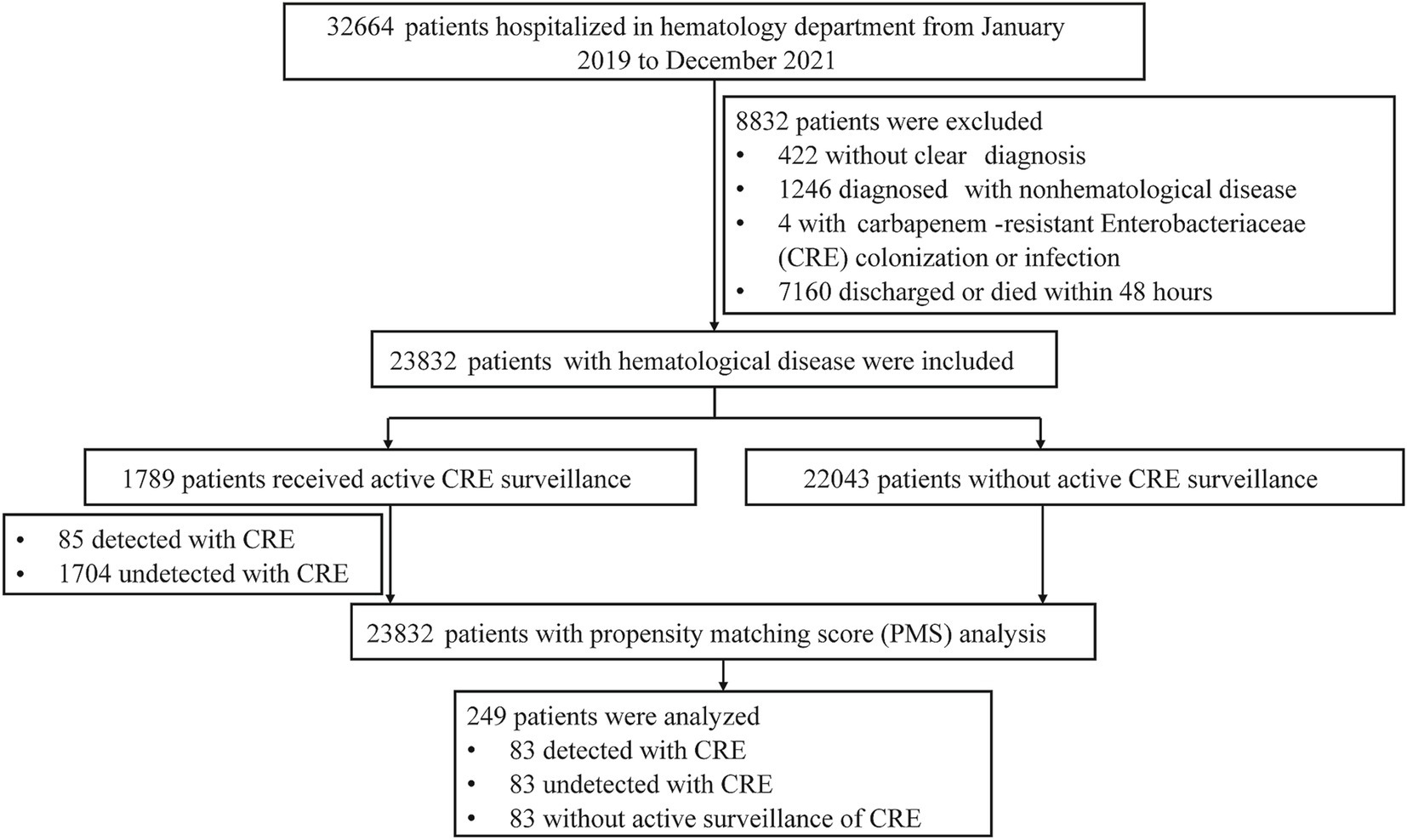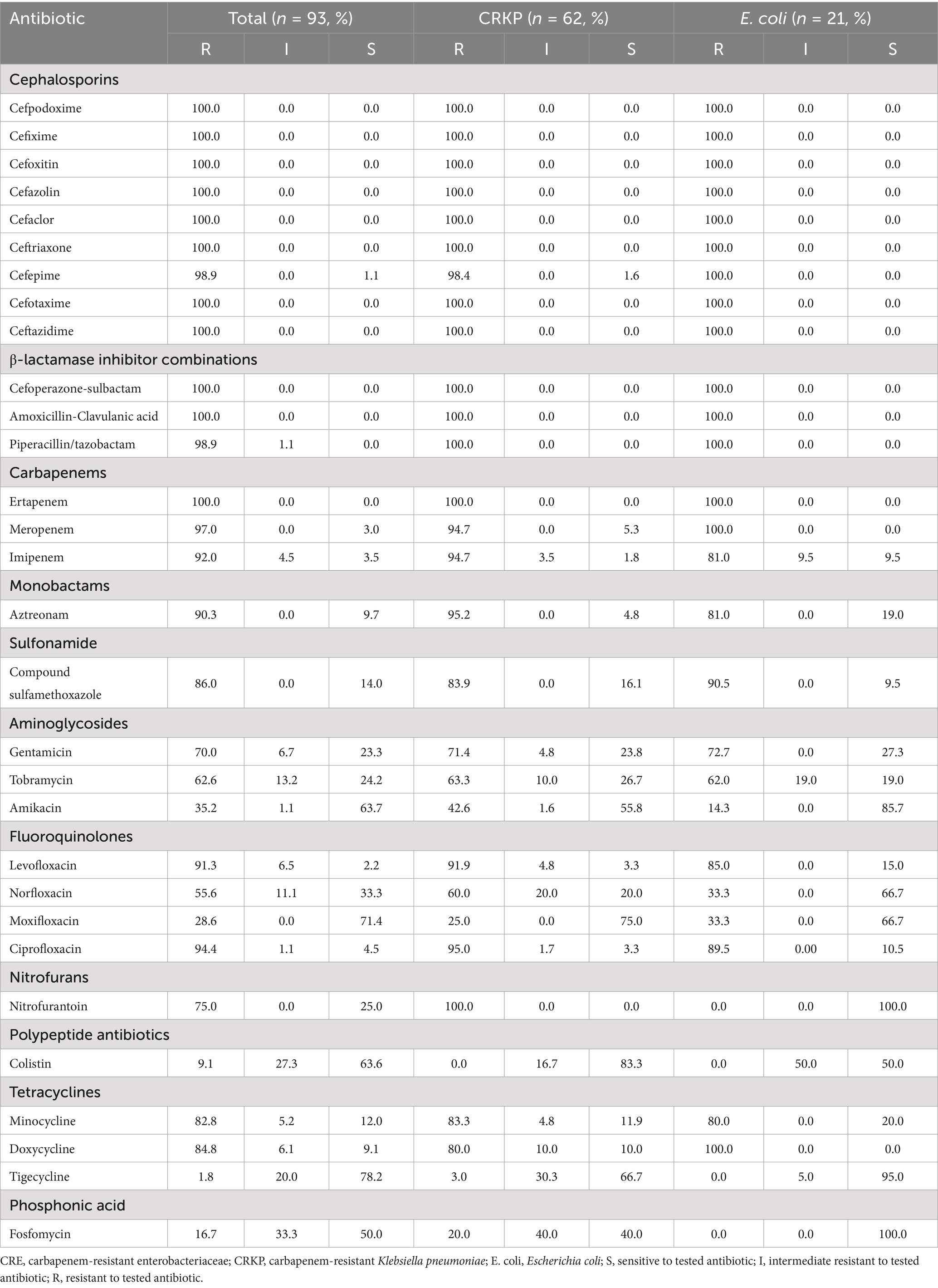- 1The Second Department of Hematology, National Regional Medical Center, Binhai Campus of the First Affiliated Hospital, Fujian Medical University, Fuzhou, China
- 2The Second Department of Hematology, The First Affiliated Hospital, Fujian Medical University, Fuzhou, China
- 3Fujian Medical University Cancer Hospital, Fujian Cancer Hospital, Fuzhou, China
- 4Department of Hematology, Fujian Institute of Hematology, Fujian Provincial Key Laboratory of Hematology, Fujian Medical University Union Hospital, Fuzhou, China
- 5Institute of Precision Medicine, Fujian Medical University, Fuzhou, China
- 6Jinjiang Municipal Hospital (Shanghai Sixth People's Hospital Fujian), Quanzhou, China
- 7The Second Affiliated Hospital of Fujian Medical University, Quanzhou, China
Introduction: Carbapenem-resistant Enterobacteriaceae (CRE) infections pose a significant threat to hematological patients, contributing to high mortality rates. This retrospective study evaluated the incidence, risk factors, and patient outcomes associated with active CRE surveillance in the hematology department.
Methods: The study identified 23,832 hematological patients between 2019 and 2021. Propensity score matching was used to align underlying diseases and admission times in a 1:1:1 ratio across three groups: detected CRE, undetected CRE, and non-active CRE surveillance. The positivity rate of active CRE surveillance was 2.1% (141/6,735), with an incidence of 4.8% (85/1,789) among patients who underwent active CRE surveillance.
Results: The distribution of the 141 isolates was as follows: Klebsiella pneumoniae (66.7%), Escherichia coli (22.6%), and others (10.7%). Independent risk factors associated with a positive result for active CRE surveillance included hematopoietic stem cell transplantation, hospital length of stay (LOS) ≥ 18 days, use of central venous catheters, steroid treatment within the past 3 months, antibiotic exposure (ß-lactam/ß-lactamase inhibitor, Echinocandins) within the last month, perianal skin ulceration within the previous 3 days, albumin < 33.4 g/L, and neutropenia lasting ≥ 7 days. In the detected CRE group, 26.5% of patients developed a CRE infection. Cox regression analysis identified diarrhea within 3 days prior to active CRE surveillance and interleukin-6 levels ≥ 39.35 pg./mL within 24 h of CRE surveillance as independent predictors of 90-day mortality. Klebsiella pneumoniae and Escherichia coli were the predominant pathogens identified in active CRE surveillance.
Discussion: The incidence of CRE infection was notably higher in the detected CRE group. Our study provides real-world evidence on the role of active CRE surveillance in survival outcomes, especially in regions like China, where CRE infections are highly prevalent. The findings suggest that active CRE surveillance could serve as an early indicator of 90-day mortality in hematology patients and should be considered for routine implementation in this population.
1 Introduction
Carbapenem-resistant Enterobacteriaceae (CRE) colonization and infection represent a critical and escalating global public health threat. An analysis estimated that approximately 2.91 million people worldwide die from bloodstream infections each year, with around 392,000 deaths attributed to carbapenem resistance (Zha et al., 2025). In China, CRE carriage among hospitalized patients is increasingly common, with multicenter studies showing intestinal colonization rates around 8% in adults with hematologic diseases, and rates as high as 16% in intensive care and hematology wards (Yi and Kim, 2021; Hu et al., 2024). Notably, a substantial proportion of colonized patients progress to infection, a Chinese cohort found that 25.9% of CRE-colonized patients developed systemic CRE infections (Xiao et al., 2024). Clinically, CRE infection is associated with limited therapeutic options and high mortality, with multicenter studies reporting 30-day mortality rates for CRE bloodstream infections of approximately 50%—significantly higher than for carbapenem-susceptible strains (Baek et al., 2024). Long-term hospitalized patients serve as key reservoirs, and although not all colonized individuals develop infection, asymptomatic carriage greatly increases the risk of subsequent disease and nosocomial transmission.
Given these challenges, active CRE screening is considered a cornerstone strategy for containment. Robust evidence from Chinese hospitals shows that universal admission screening combined with pre-emptive contact isolation in high-risk wards can dramatically reduce hospital-acquired CRE infections. A multicenter study reported that, in neonatal intensive care units, this approach lowered CRE infection rates from 1.96 to 0.63%, and in general neonatal wards from 0.57 to 0.30% (Yin et al., 2020). Similarly, in adult emergency intensive care units, rapid molecular screening plus bundled infection control interventions reduced overall CRE incidence from 5.24 to 3.48% (Zhou et al., 2023). These findings underscore that sustained, high-compliance active surveillance and comprehensive prevention strategies are highly effective for curbing CRE transmission, especially among immunocompromised, critically ill, and long-stay patients (Yang et al., 2023).
Patients with hematological diseases (HDs) are especially vulnerable to multidrug-resistant (MDR) infections, notably CRE. Multicenter studies have shown that CRE colonization or infection is independently associated with more than a threefold increase in 30-day mortality among patients with acute leukemia receiving intensive chemotherapy (Ballo et al., 2019). Accordingly, this study aims to evaluate the impact of active CRE surveillance in the hematology ward and to identify mortality-associated risk factors by comparing patients who underwent active surveillance with those who did not.
2 Materials and methods
2.1 Study design and patient selection
This study included patients with hematological diseases, who were followed at the Department of Hematology at Fujian Medical University Union Hospital (FMUH), a large general teaching hospital in Fuzhou, China, between January 1, 2019, and December 31, 2021. The medical records of these patients were retrospectively reviewed. The inclusion criteria were: admission to the hematology department and a diagnosis of any hematological disease. Exclusion criteria included unclear diagnoses, non-hematological disease diagnoses, CRE colonization or infection, and discharge or death within 48 h. A total of 23,832 patients met the inclusion criteria, and 1,789 of these patients received active CRE surveillance. After Propensity Score Matching (PSM) based on types of hematological diseases and admission time, 249 patients were enrolled and divided into three groups (Table 1). Patients with a positive culture from active CRE surveillance were categorized to the “detected CRE” group, those with a negative culture as the “undetected CRE” group, and those who did not undergo active CRE surveillance as the “non-active CRE surveillance” group. The study flow chat is presented in Figure 1. For patients undergoing multiple active CRE surveillances, clinical data from the first positive result or the first surveillance during the same hospitalization were used. For patients without active CRE surveillance, clinical data from the time of admission during the same hospitalization were included. This study was approved by the ethics committee of Fujian Medical University Union Hospital, and written informed consent was obtained from all patients in accordance with the Helsinki Declaration.
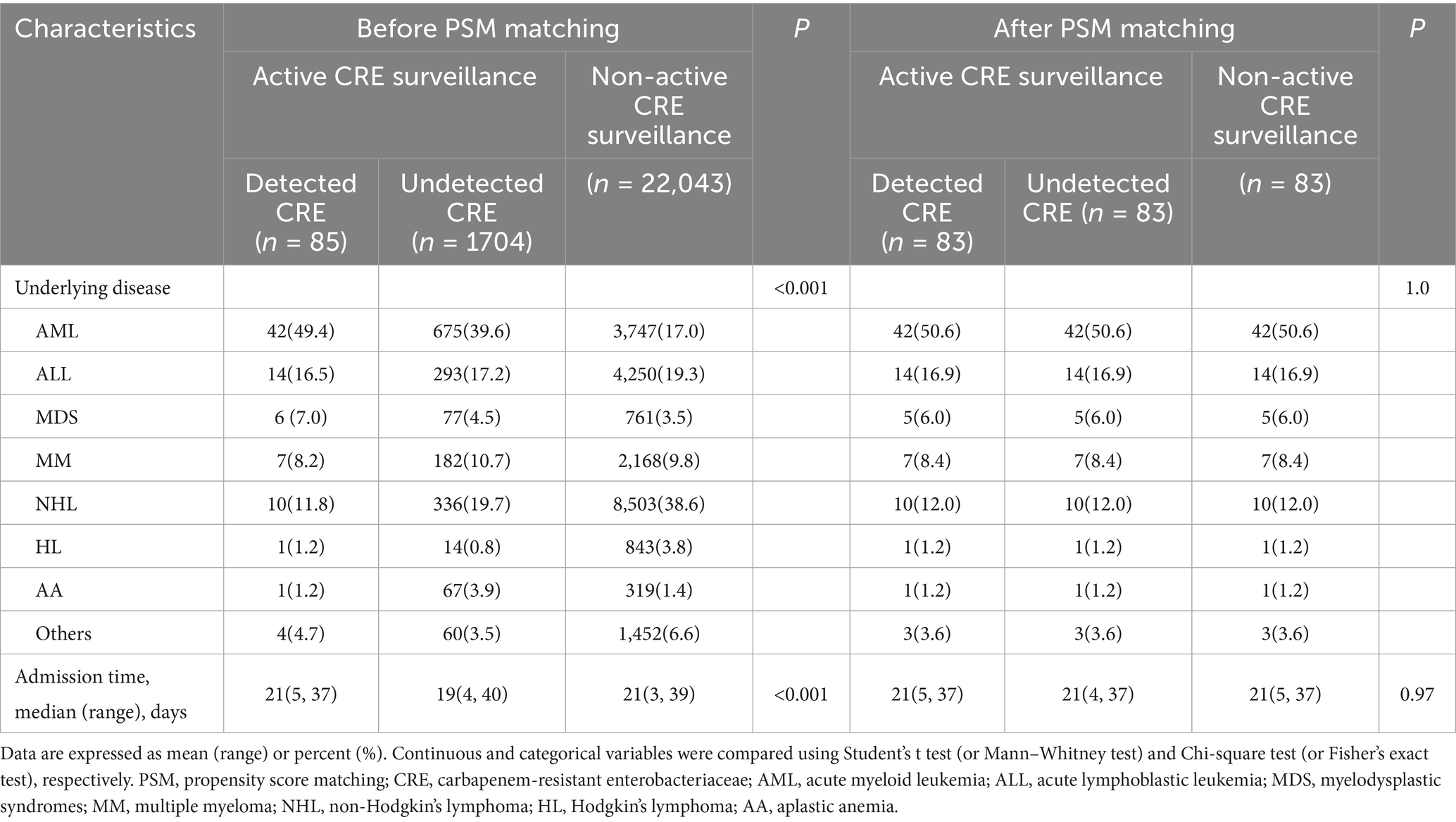
Table 1. Group comparisons before and after propensity score matching (PSM) for patient’s characteristics.
2.2 Active CRE surveillances and antimicrobial susceptibility
Stool, perianal and oropharyngeal swabs were collected within 48 h of admission. Routine follow-up screening was then performed once weekly for standard-risk hematology in-patients and twice weekly (every Monday and Thursday) for high-risk subgroups (allogeneic HSCT recipients, patients with expected neutropenia ≥ 7 days, or those in non-remission status) until discharge or death. Additional ‘on-demand’ screening was initiated if unexplained fever, diarrhea, or perianal ulceration developed. A total of 6,735 stool, perianal, or oropharyngeal swabs were collected from 1,789 patients and inoculated onto eosin methylene blue (EMB) agar plates with a 10 μg meropenem disk (Giani et al., 2012; Alizadeh et al., 2018). The plates were incubated at 35°C for 24 h, resulting in the identification of 141 CRE isolates using the Vitek-2 Compact System (BioMérieux, Marcy-l’Étoile, France). These isolates were stored at −80°C for antimicrobial susceptibility testing. Antimicrobial susceptibility was evaluated for the following antibiotics: Cefpodoxime, Cefixime, Cefoxitin, Cefazolin, Cefaclor, Ceftriaxone, Cefepime, Cefotaxime, Ceftazidime, Cefoperazone-sulbactam, Amoxicillin-clavulanic acid, Piperacillin-tazobactam, Ertapenem, Meropenem, Imipenem, Aztreonam, Compound Sulfamethoxazole, Gentamicin, Tobramycin, Amikacin, Levofloxacin, Norfloxacin, Moxifloxacin, Ciprofloxacin, Nitrofurantoin, Colistin, Minocycline, Doxycycline, Tigecycline, and Fosfomycin. Testing was performed using agar dilution and microdilution methods according to Clinical and Laboratory Standards Institute (CLSI) guidelines (Humphries et al., 2021). Quality control was ensured with Escherichia coli ATCC 25922 and Klebsiella pneumoniae ATCC 700603 strains, as recommended by CLSI guidelines.
2.3 Parameter definitions
CRE are a group of Enterobacteriaceae bacteria that exhibit resistance to at least one carbapenem antibiotic, defined by minimum inhibitory concentrations (MICs) of ≥ 4 μg/mL for doripenem, meropenem, or imipenem, or ≥ 2 μg/mL for ertapenem, or are documented to produce carbapenemase. For organisms with intrinsic resistance to imipenem (e.g., Morganella morganii, Proteus spp., Providencia spp.), resistance to carbapenems other than imipenem is required (Chen et al., 2024a). In our study, molecular methods (e.g., PCR detection of carbapenemase genes such as KPC, NDM, and OXA-48) were not employed, and thus CRE were identified solely based on phenotypic antimicrobial susceptibility testing.
Neutropenia was defined as an absolute neutrophil count (ANC) of ≤ 0.5 × 109/L, or ≤ 1.0 × 109/L with a predicted decline of ≤ 0.5 × 109/L within 24–48 h (El Omri et al., 2024; Islas-Muñoz et al., 2024). MDR was defined as bacterial resistance to three or more classes of antibiotics (Thaden et al., 2017).
2.4 Statistical analysis
We performed one-to-one-to-one nearest-neighbor matching without replacement among the three groups (CRE-detected, CRE-undetected, no surveillance). Propensity scores were estimated using a multinomial logistic regression model including key clinical covariates. Matching was implemented with the ‘MatchIt’ package in R (version 4.1.0), using a caliper width of 0.2 times the standard deviation of the logit of the propensity score, as recommended (Austin, 2011). Continuous variables were expressed as medians with interquartile ranges, while categorical variables were presented as counts and percentages, differences in normally distributed continuous variables between groups were assessed using the Student’s t-test, whereas Mann–Whitney U tests was applied for non-normally distributed variables. Categorical variables were compared using the Chi-square test or Fisher’s exact test. Multivariate analysis was conducted using logistic regression models to identify risk factors associated with positive results in active CRE surveillance. Odds ratios (OR) with 95% confidence intervals (CI) were reported. For assessing risk factors for 90-day mortality in hematology patients, Cox proportional hazards regression was used, with hazard ratios (HR) and 95% CI reported. All statistical tests were two-sided, and a p-value < 0.05 was considered statistically significant. Data analyzes were preformed using SPSS version 26.0 (SPSS Inc., Chicago, IL).
3 Results
3.1 Characteristics of patients with hematological diseases
The characteristics of the patients in the entire cohort are summarized in Table 2. No significant differences in sex distribution were observed among the three groups (p = 0.754), and the median age was comparable (46 years vs. 47 years vs. 47 years). The prevalence of diabetes was also similar among the groups (14.5% vs. 20.5% vs. 13.3%). Notably, the hospital length of stay (LOS) was significantly longer in the detected CRE group compared to other groups (p < 0.001). Patients in the non-active CRE surveillance group had the highest remission rate and were the least likely to have undergone hematopoietic stem cell transplantation. Additionally, hospitalization costs were highest in the detected CRE group, followed by the undetected CRE group. The median follow-up times were 110, 268, and 270 days in the three groups, respectively.
3.2 Positive rate of active CRE surveillance and distribution of CRE strains
A total of 6,735 samples from 1,789 patients underwent active CRE surveillance. The positivity rate of active CRE surveillance, based on stool, perianal, or oropharyngeal swabs, was approximately 2.1% (141/6,735). Among the patients, 4.8% (85/1,789) were detected with CRE, with the highest detection rate observed in 2019 (7.0%), while the rates in 2020 and 2021 were comparatively lower (Seen in Supplementary Figure 1). Among the 3,215 samples provided by 304 patients who underwent simultaneous testing of stool, perianal swabs, and oropharyngeal swabs, stool samples exhibited the highest positivity rate at 2.8%, followed by perianal swabs and oropharyngeal swabs (Figure 2). Pathogens isolated from stool or perianal swabs from the same patient were identified as originating from the same source. Notably, 48 strains among the total 141 were excluded as they originated from the same source. Of the 93 strains from different sources, the most frequently identified pathogens were Klebsiella pneumoniae (66.7%), followed by Escherichia coli (22.6%), Enterobacter cloacae (6.5%), and other CRE strains (Seen in Supplementary Table1).
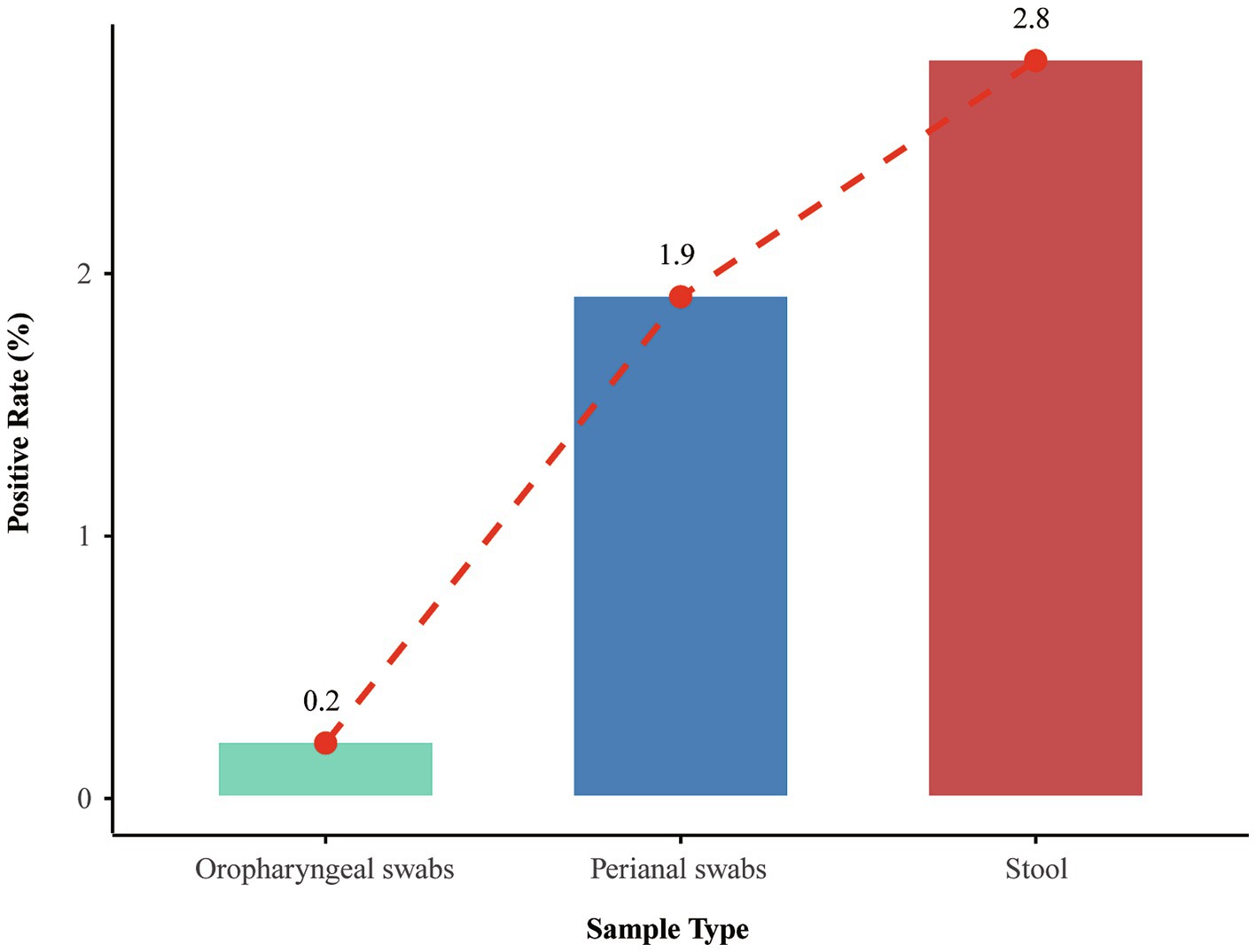
Figure 2. Positive rates of active CRE screening across 3,215 stool, perianal, and oropharyngeal swab samples collected from 304 patients with simultaneous testing.
3.3 Antimicrobial resistance of major CRE pathogens
Our antimicrobial susceptibility data for the 93 pathogens showed that CRE strains were nearly 100% resistant to cephalosporins and β-lactamase inhibitor combinations, although they displayed minimal resistance to cefepime, a fourth-generation cephalosporin. Notably, CRE strains were generally more susceptible to colistin (63.6%), moxifloxacin (71.4%), tigecycline (78.2%), and amikacin (63.7%).
Among the Klebsiella pneumoniae isolates, 100.0% were resistant to cephalosporins, β-lactamase inhibitor combinations, and nitrofurantoin, except for cefepime. Over 90.0% of K. pneumoniae isolates demonstrated resistance to carbapenems, monobactams, levofloxacin, and ciprofloxacin. However, these isolates exhibited relatively low resistance rates to moxifloxacin (25.0%) and fosfomycin (20.0%). Interestingly, only 3.0% of K. pneumoniae isolates were resistant to tigecycline, and no resistance was observed to colistin.
Similarly, Escherichia coli isolates displayed high resistance to cephalosporins and β-lactamase inhibitor combinations. In contrast, only 33.3% of E. coli strains were resistant to norfloxacin and moxifloxacin. Notably, none of the E. coli strains exhibited resistance to fosfomycin, nitrofurantoin, colistin, or tigecycline (Table 3).
3.4 Risk factors for isolation of CRE from hematological patients
Univariate analysis identified numerous factors significantly associated with CRE isolation among hematology patients. After adjustment in a multivariate logistic regression model, a subset of these factors remained independent risk factors for a positive CRE surveillance culture. Specifically, patients who underwent HSCT, had a prolonged hospital stay (LOS ≥ 18 days), had a central venous catheter in place, or received recent steroid therapy were at higher risk of CRE isolation. In addition, exposure to certain antimicrobial agents (β-lactam/β-lactamase inhibitor antibiotics and echinocandins), the presence of perianal skin ulceration, hypoalbuminemia (albumin < 33.4 g/L), and prolonged neutropenia (duration ≥ 7 days) were independently associated with an increased likelihood of CRE detection. These factors constituted the final multivariate model for CRE isolation. (Table 4; details in Supplementary Table 2).
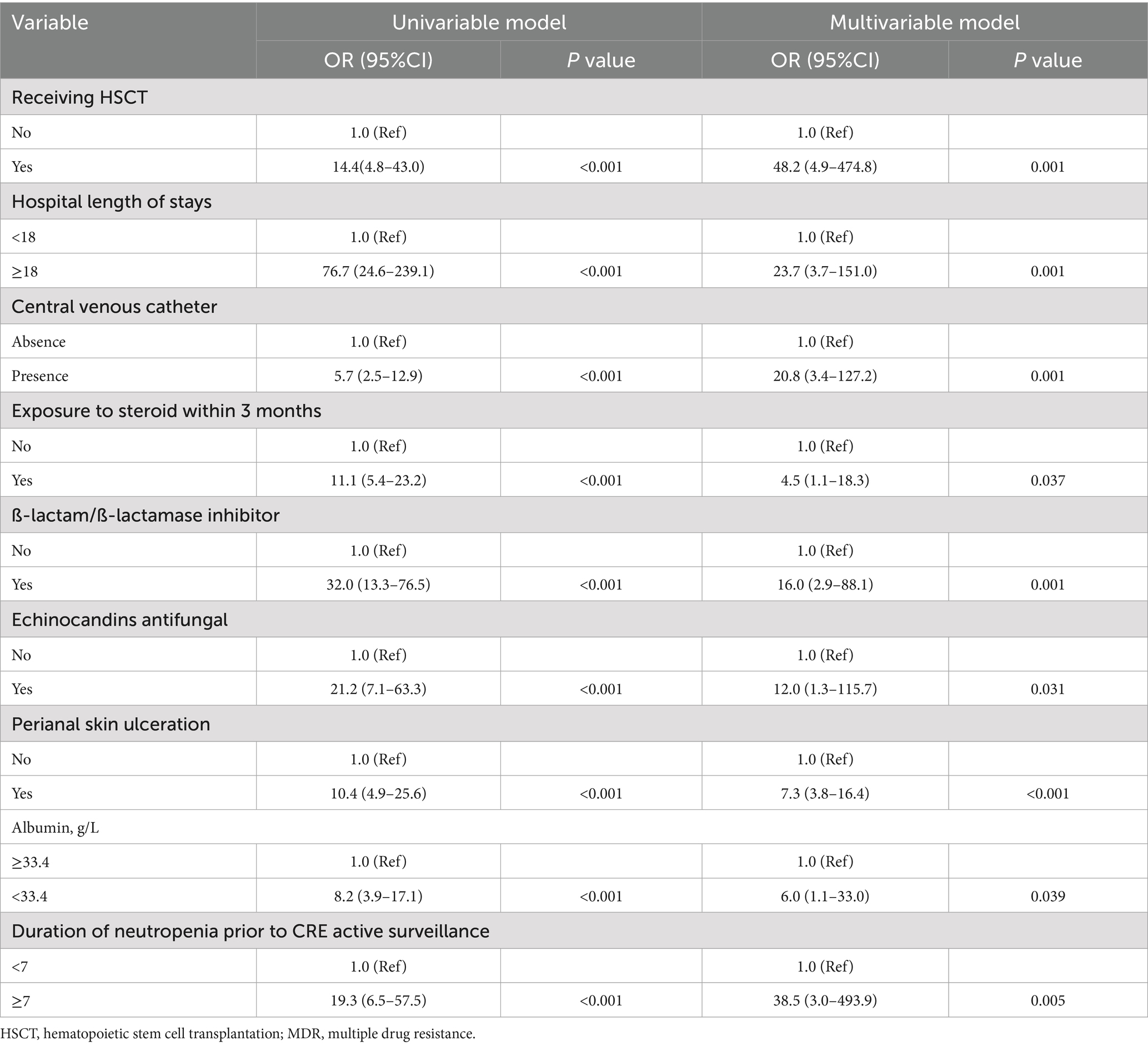
Table 4. Univariate and multivariate logistic regression analysis of risk factors for isolation of CRE.
3.5 Outcomes and risk factors for 90-day mortality in the patients receiving active CRE surveillance
There was no significant difference in the mortality rates at day 30 and day 60 between the detected and undetected CRE groups (Figures 3A,B). However, the detected CRE group exhibited a higher mortality rate at day 90 compared to the undetected group, as shown in Figure 3C. Among patients undergoing active CRE surveillance, univariate analysis showed that many clinical and laboratory factors were associated with higher 90-day mortality. In the multivariate Cox regression model, however, only two variables emerged as significant independent predictors of 90-day mortality. Specifically, patients who experienced diarrhea within the 3 days prior to CRE surveillance and those with an elevated interleukin-6 level (≥ 39.35 pg./mL) at the time of surveillance had a substantially higher risk of death by 90 days. (Table 5; details in Supplementary Table 3).
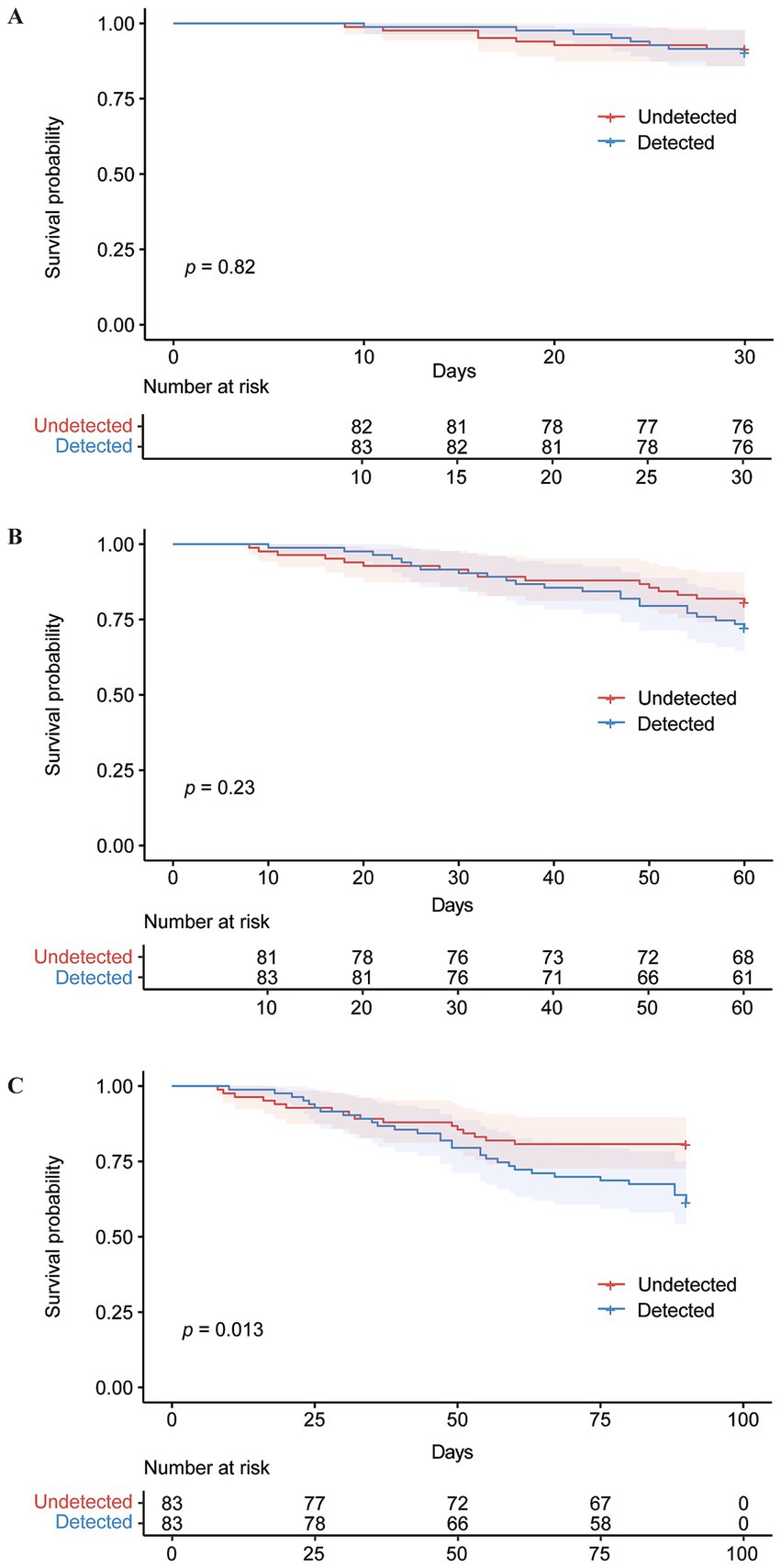
Figure 3. Survival analysis of patients in the Detected CRE and Undetected CRE groups using Kaplan–Meier curves. (A) Kaplan–Meier estimates of 30-day patient mortality for the Detected CRE and Undetected CRE groups. (B) Kaplan–Meier estimates of 60-day patient mortality for the Detected CRE and Undetected CRE groups. (C) Kaplan–Meier estimates of 90-day patient mortality for the Detected CRE and Undetected CRE groups.
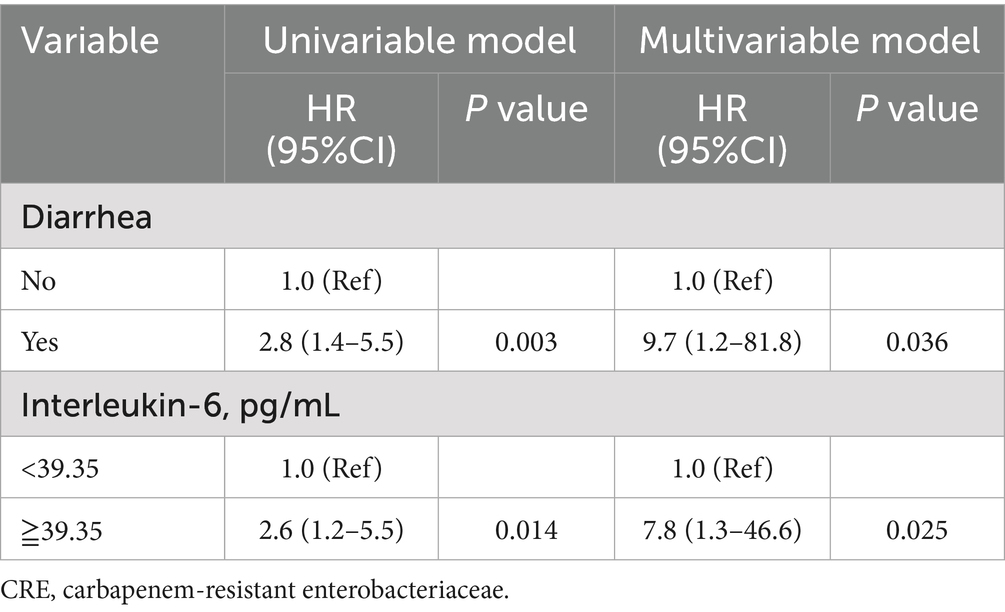
Table 5. Univariate and multivariate cox regression analysis of risk factors associated with 90-day mortality among patients detected CRE.
3.6 Impact of CRE screening frequency on infection and survival outcomes
In the detected CRE group, 22 patients developed CRE infection, resulting in an infection rate of 26.5%. In contrast, only 1 patient in the undetected CRE group was infected, with an infection rate of 1.2%. Among patients in the detected CRE group, a higher screening frequency was significantly more effective in the early detection of CRE infections compared to a lower screening frequency (p = 0.005, Figure 4A). However, the frequency of CRE screening did not influence overall survival, as no statistically significant difference observed (p = 0.70, Figure 4B).
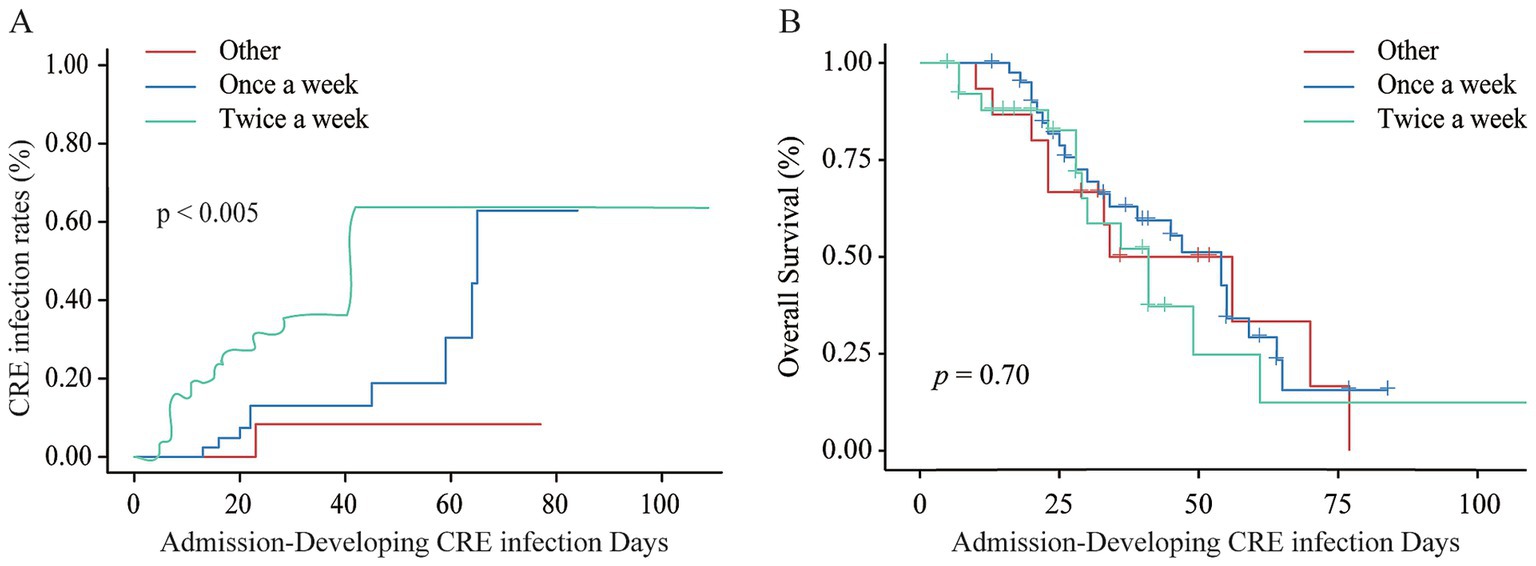
Figure 4. Impact of CRE screening frequency on infection rates and survival outcomes. (A) CRE infection rates between high and low screening frequencies in the detected CRE group. (B) Overall survival comparison between different CRE screening frequencies in the detected CRE group.
4 Discussion
CRE remains a global public health threat, particularly for immunocompromised patients such as those with HD and transplant recipients. Currently, treatment options for CRE are limited, with polymyxin, tigecycline, and fosfomycin as the primary therapies. Additionally, ceftazidime-avibactam has emerged as a common treatment option for CRE infections (Guo et al., 2023; Zeng et al., 2023). The prognosis for HD patients with CRE infections is generally poor (Lalaoui et al., 2020; Chen et al., 2024b), though combination therapies and newer drugs may provide improved outcomes. Understanding the epidemiological characteristics, drug resistance profiles, and mechanisms of antibiotic resistance in CRE is crucial for developing effective antimicrobial strategies for HD patients. In this study, we analyzed the distribution of CRE under active surveillance with Klebsiella pneumoniae and Escherichia coli being the predominant strains, together accounting for 89.3%. These findings align with previous studies (Satlin et al., 2014; Pouch and Satlin, 2017).
The primary resistance mechanisms in CRE are enzyme synthesis, efflux pumps, and porin mutations, with enzyme synthesis being the major mechanism. Enzymes involved in carbapenem resistance belong to three classes (Ambler class A, B, and D), including KPC, NDM, IMP, VIM, and OXA-48, among others (Wang et al., 2021). These β-lactamase confer resistance by hydrolyzing carbapenems and other β-lactam antimicrobials, collectively referred to as carbapenemases. In our analysis, resistance rates to fosfomycin, colistin, and tigecycline were determined to be 16.7, 9.1, and 1.8%, respectively. Interestingly, resistance to fosfomycin and tigecycline was almost exclusively associated with E. coli. Among 294 non-duplicated CRKP strains from two tertiary hospitals in China, 18.71% (55/294) exhibited fosfomycin resistance. Globally, reported resistance rates to fosfomycin and colistin among CRE strains vary, with studies showing rates of 12.3–67.35% for fosfomycin and 9.1–76.19% for colistin. Notably, increasing colistin resistance has been highlighted in several reports (Qamar et al., 2017; Süzük Yıldız et al., 2019; El-Mahallawy et al., 2022). The optimal treatment strategy for CRE infections remains controversial; however, combination therapy has shown promise in significantly reducing morbidity and may represent the most effective approach for controlling these infections (Hu et al., 2022). To further refine treatment approaches, a Personalized Randomized Controlled Trial design has been introduced to evaluate strategies that balance efficacy and safety (Walker et al., 2021). These efforts, coupled with initiatives to mitigate the spread of resistant microbes and develop novel antibiotics or effective therapies, are critical for reducing mortality risk.
Patients with HD or those who have undergone HSCT are highly vulnerable to CRE infections, with mortality rates nearing 60%. Mortality from CRE bacteremia may be even higher due to delays of 2–3 days in initiating CRE-active therapy after bacteremia onset (Satlin et al., 2016). Our data indicate that patients undergoing HSCT, using central venous catheters, exposed to antibiotics (e.g., β-lactam/β-lactamase inhibitor combinations, echinocandins) in the past month, presenting with perianal skin ulceration in the past 3 days, or experiencing neutropenia ≥ 7 days, face an increased risk of CRE detection. These findings are consistent with previous reports (Ballo et al., 2019; Cao et al., 2022). Additionally, hospital LOS ≥ 18 days, recent steroid use (within 3 months), and albumin levels < 33.4 g/L were associated with higher CRE positivity, reflecting the complexity of HD patient management. This study highlights the need for vigilant monitoring of HD patients with these risk factors, along with implementing preventive measures such as reducing cross-transmission, improving hand hygiene, and optimizing antimicrobial stewardship.
Research on HD patients during the same period showed that 18.4% of patients colonized with CRE developed a subsequent CRE infection (Chen et al., 2023). Our data indicated a slightly higher rate, with 26.5% of the active screen-positive group experiencing a CRE infection in the later stages of their disease. This highlights the increased risk of subsequent infections in patients colonized with CRE. A study at an academic hospital in the southeastern United States implemented an active surveillance testing (AST) program, which improved compliance and increased the acceptance rate of CRE screening samples. Such programs enable timely isolation of CRE-positive patients, effectively preventing the spread of infection (Sova et al., 2021). Therefore, active CRE surveillance is a critical component of a comprehensive CRE prevention strategy, significantly reducing infection rates.
A study on AML patients found significantly reduced 60- and 90-day survival rates in those colonized with CRE compared to non-colonized patients (Ballo et al., 2019). Similarly, research in an ICU demonstrated that CRE colonization was associated with increased 90-day mortality, underscoring the adverse impact of CRE colonization on clinical outcomes (McConville et al., 2017). Consistent with these findings, our data showed a higher 90-day mortality rate in the detected CRE group compared to the undetected group. Independent risk factors for 90-day mortality included diarrhea within 3 days before CRE active surveillance and IL-6 levels ≥ 39.35 pg./mL within 24 h of surveillance. Among serum biomarkers, IL-6 not only showed the strongest response to early fever onset in HD patients, surpassing the composite index of CRP, IL-6, and PCT (Carcò et al., 2022), but was also closely associated with the occurrence of bacteremia (Lee et al., 2022).
The retrospective nature of our study presents inherent limitations. Despite adjusting for baseline differences such as hematological diseases and admission time, additional imbalances may still exist. Although PSM helped reduce confounding by measured covariates, it cannot account for unmeasured confounding, and the matched cohort may not fully represent the original study population, since patients without suitable matches are excluded. The modest sample size and limited number of outcome events resulted in wide confidence intervals for certain variables, notably diarrhea and elevated IL-6 levels, indicating potential instability and risks of overfitting or quasi-complete separation in our multivariate Cox regression analyses. Additionally, molecular confirmation methods, including PCR detection of carbapenemase genes, were not utilized. Therefore, our phenotypic-based definition might encompass non-carbapenemase-producing strains, potentially limiting the generalizability of our findings to settings routinely employing molecular diagnostics. Future larger multicenter studies employing molecular confirmation and more robust statistical methods such as penalized regression would enhance the precision and external validity of these findings. Nonetheless, our study provides valuable insights, suggesting that active CRE surveillance may be associated with 90-day mortality risk in hematology patients.
5 Conclusion
Our study highlights the elevated risk of CRE infection and mortality in the detected CRE group under active surveillance in the hematology department. Increasing the frequency of active screening significantly reduces infection rates. Additionally, active CRE surveillance may help identify patients at increased risk of 90-day mortality, based on observed associations in this study. Further studies are warranted to explore and refine proactive strategies for active CRE surveillance, aiming to better control CRE infection and transmission.
Data availability statement
The original contributions presented in the study are included in the article/Supplementary material, further inquiries can be directed to the corresponding authors.
Ethics statement
The studies involving humans were approved by Ethics committee of Fujian Medical University Union Hospital. The studies were conducted in accordance with the local legislation and institutional requirements. The participants provided their written informed consent to participate in this study.
Author contributions
SC: Writing – original draft. JF: Conceptualization, Data curation, Formal analysis, Writing – original draft, Writing – review & editing. TX: Writing – original draft. JR: Writing – original draft. HZ: Writing – review & editing. HK: Writing – review & editing. DC: Writing – review & editing. JX: Writing – review & editing. CY: Writing – review & editing. JS: Writing – review & editing. CH: Writing – review & editing. XZ: Writing – review & editing. JL: Writing – review & editing. XY: Writing – review & editing. ZC: Writing – review & editing. JH: Writing – review & editing. TY: Conceptualization, Resources, Supervision, Writing – review & editing.
Funding
The author(s) declare that financial support was received for the research and/or publication of this article. This work was supported by National Natural Science Foundation of China (U23A20419, 82070177), Hospital talent scientific research project (YJRC4415), Project of Fujian Province Department of Science & Technology (2023Y9079, 2022Y4013, 2022J01240), and Startup Fund for Scientific Research Project of Fujian Medical University (2022QH2211, 2023QH2010).
Acknowledgments
The authors would like to thank all the nurses and physicians at the Center who contributed to the management of patient care.
Conflict of interest
The authors declare that the research was conducted in the absence of any commercial or financial relationships that could be construed as a potential conflict of interest.
Generative AI statement
The authors declare that no Gen AI was used in the creation of this manuscript.
Publisher’s note
All claims expressed in this article are solely those of the authors and do not necessarily represent those of their affiliated organizations, or those of the publisher, the editors and the reviewers. Any product that may be evaluated in this article, or claim that may be made by its manufacturer, is not guaranteed or endorsed by the publisher.
Supplementary material
The Supplementary material for this article can be found online at: https://www.frontiersin.org/articles/10.3389/fmicb.2025.1561587/full#supplementary-material
References
Alizadeh, N., Rezaee, M. A., Kafil, H. S., Barhaghi, M. H. S., Memar, M. Y., Milani, M., et al. (2018). Detection of carbapenem-resistant Enterobacteriaceae by chromogenic screening media. J. Microbiol. Methods 153, 40–44. doi: 10.1016/j.mimet.2018.09.001
Austin, P. C. (2011). An introduction to propensity score methods for reducing the effects of confounding in observational studies. Multivariate Behav. Res. 46, 399–424. doi: 10.1080/00273171.2011.568786
Baek, M. S., Kim, J. H., Park, J. H., Kim, T. W., Jung, H. I., and Kwon, Y. S. (2024). Comparison of mortality rates in patients with carbapenem-resistant Enterobacterales bacteremia according to carbapenemase production: a multicenter propensity-score matched study. Sci. Rep. 14:597. doi: 10.1038/s41598-023-51118-9
Ballo, O., Tarazzit, I., Stratmann, J., Reinheimer, C., Hogardt, M., Wichelhaus, T. A., et al. (2019). Colonization with multidrug resistant organisms determines the clinical course of patients with acute myeloid leukemia undergoing intensive induction chemotherapy. PLoS One 14:e0210991. doi: 10.1371/journal.pone.0210991
Cao, W., Zhang, J., Bian, Z., Li, L., Zhang, S., Qin, Y., et al. (2022). Active screening of intestinal colonization of Carbapenem-resistant Enterobacteriaceae for subsequent bloodstream infection in allogeneic hematopoietic stem cell transplantation. Infect Drug Resist 15, 5993–6006. doi: 10.2147/idr.S387615
Carcò, D., Castorina, P., Guardo, P., Iachelli, V., Pace, T., Scirè, P., et al. (2022). Combination of Interleukin-6, C-reactive protein and Procalcitonin values as predictive index of Sepsis in course of fever episode in adult Haematological patients: observational and statistical study. J. Clin. Med. 11:800. doi: 10.3390/jcm11226800
Chen, J., Hu, Q., Zhou, P., and Deng, S. (2024a). Ceftazidime-avibactam versus polymyxins in treating patients with carbapenem-resistant Enterobacteriaceae infections: a systematic review and meta-analysis. Infection 52, 19–28. doi: 10.1007/s15010-023-02108-6
Chen, Y., Huang, J., Dong, L., Xu, B., Li, L., Zhao, Z., et al. (2024b). Clinical and genomic characterization of carbapenem-resistant Enterobacterales bloodstream infections in patients with hematologic malignancies. Front. Cell. Infect. Microbiol. 14:1471477. doi: 10.3389/fcimb.2024.1471477
Chen, X., Wen, X., Jiang, Z., and Yan, Q. (2023). Prevalence and factors associated with carbapenem-resistant Enterobacterales (CRE) infection among hematological malignancies patients with CRE intestinal colonization. Ann. Clin. Microbiol. Antimicrob. 22:3. doi: 10.1186/s12941-023-00554-6
El Omri, H., Padmanabhan, R., Taha, R. Y., Kassem, N., Elsabah, H., Ellahie, A. Y., et al. (2024). Dissecting bloodstream infections in febrile neutropenic patients with hematological malignancies, a decade-long single center retrospective observational study (2009-2019). J. Infect. Public Health 17, 152–162. doi: 10.1016/j.jiph.2023.11.017
El-Mahallawy, H. A., El Swify, M., Abdul Hak, A., and Zafer, M. M. (2022). Increasing trends of colistin resistance in patients at high-risk of carbapenem-resistant Enterobacteriaceae. Ann. Med. 54, 1–9. doi: 10.1080/07853890.2022.2129775
Giani, T., Tascini, C., Arena, F., Ciullo, I., Conte, V., Leonildi, A., et al. (2012). Rapid detection of intestinal carriage of Klebsiella pneumoniae producing KPC carbapenemase during an outbreak. J. Hosp. Infect. 81, 119–122. doi: 10.1016/j.jhin.2012.04.004
Guo, Y., Ding, L., Yang, Y., Han, R., Yin, D., Wu, S., et al. (2023). Multicenter antimicrobial resistance surveillance of clinical isolates from major hospitals - China, 2022. China CDC Wkly 5, 1155–1160. doi: 10.46234/ccdcw2023.217
Hu, Q., Chen, J., Sun, S., and Deng, S. (2022). Mortality-related risk factors and novel antimicrobial regimens for Carbapenem-resistant Enterobacteriaceae infections: a systematic review. Infect. Drug Resist. 15, 6907–6926. doi: 10.2147/idr.S390635
Hu, H., Wang, Y., Sun, J., Wang, Y., Zhou, J., Shi, Q., et al. (2024). Risk factors and molecular epidemiology of intestinal colonization by carbapenem-resistant gram-negative bacteria in patients with hematological diseases: a multicenter case–control study. Microbiol. Spectr. 12:e0429923. doi: 10.1128/spectrum.04299-23
Humphries, R., Bobenchik, A. M., Hindler, J. A., and Schuetz, A. N. (2021). Overview of changes to the clinical and laboratory standards institute performance standards for antimicrobial susceptibility testing, M100, 31st edition. J. Clin. Microbiol. 59:e0021321. doi: 10.1128/jcm.00213-21
Islas-Muñoz, B., Volkow-Fernández, P., Silva-Zamora, J., Ramírez-Ibarguen, A., and Cornejo-Juárez, P. (2024). Mortality in patients with hematological malignancies, febrile neutropenia, and septic shock. J. Infect. Dev. Ctries. 18, 235–242. doi: 10.3855/jidc.17451
Lalaoui, R., Javelle, E., Bakour, S., Ubeda, C., and Rolain, J. M. (2020). Infections due to Carbapenem-resistant Bacteria in patients with hematologic malignancies. Front. Microbiol. 11:1422. doi: 10.3389/fmicb.2020.01422
Lee, E. H., Lee, K. H., Song, Y. G., and Han, S. H. (2022). Discrepancy of C-reactive protein, Procalcitonin and Interleukin-6 at hospitalization: infection in patients with Normal C-reactive protein, Procalcitonin and high Interleukin-6 values. J. Clin. Med. 11:7324. doi: 10.3390/jcm11247324
McConville, T. H., Sullivan, S. B., Gomez-Simmonds, A., Whittier, S., and Uhlemann, A. C. (2017). Carbapenem-resistant Enterobacteriaceae colonization (CRE) and subsequent risk of infection and 90-day mortality in critically ill patients, an observational study. PLoS One 12:e0186195. doi: 10.1371/journal.pone.0186195
Pouch, S. M., and Satlin, M. J. (2017). Carbapenem-resistant Enterobacteriaceae in special populations: solid organ transplant recipients, stem cell transplant recipients, and patients with hematologic malignancies. Virulence 8, 391–402. doi: 10.1080/21505594.2016.1213472
Qamar, S., Shaheen, N., Shakoor, S., Farooqi, J., Jabeen, K., and Hasan, R. (2017). Frequency of colistin and fosfomycin resistance in carbapenem-resistant Enterobacteriaceae from a tertiary care hospital in Karachi. Infect Drug Resist. 10, 231–236. doi: 10.2147/idr.S136777
Satlin, M. J., Cohen, N., Ma, K. C., Gedrimaite, Z., Soave, R., Askin, G., et al. (2016). Bacteremia due to carbapenem-resistant Enterobacteriaceae in neutropenic patients with hematologic malignancies. J. Infect. 73, 336–345. doi: 10.1016/j.jinf.2016.07.002
Satlin, M. J., Jenkins, S. G., and Walsh, T. J. (2014). The global challenge of carbapenem-resistant Enterobacteriaceae in transplant recipients and patients with hematologic malignancies. Clin. Infect. Dis. 58, 1274–1283. doi: 10.1093/cid/ciu052
Sova, C., Lewis, S. S., Smith, B. A., and Reynolds, S. (2021). Multi-faceted strategies improve collection compliance and sample acceptance rate for carbapenem-resistant Enterobacteriaceae (CRE) active surveillance testing. Am. J. Infect. Control 49, 1043–1047. doi: 10.1016/j.ajic.2021.01.021
Süzük Yıldız, S., Kaşkatepe, B., Şimşek, H., and Sarıgüzel, F. M. (2019). High rate of colistin and fosfomycin resistance among carbapenemase-producing Enterobacteriaceae in Turkey. Acta Microbiol. Immunol. Hung. 66, 103–112. doi: 10.1556/030.65.2018.042
Thaden, J. T., Li, Y., Ruffin, F., Maskarinec, S. A., Hill-Rorie, J. M., Wanda, L. C., et al. (2017). Increased costs associated with bloodstream infections caused by multidrug-resistant gram-negative Bacteria are due primarily to patients with hospital-acquired infections. Antimicrob. Agents Chemother. 61, e01709–e01716. doi: 10.1128/aac.01709-16
Walker, A. S., White, I. R., Turner, R. M., Hsu, L. Y., Yeo, T. W., White, N. J., et al. (2021). Personalised randomised controlled trial designs-a new paradigm to define optimal treatments for carbapenem-resistant infections. Lancet Infect. Dis. 21, e175–e181. doi: 10.1016/s1473-3099(20)30791-x
Wang, H., Min, C., Li, J., Yu, T., Hu, Y., Dou, Q., et al. (2021). Characterization of fosfomycin resistance and molecular epidemiology among carbapenem-resistant Klebsiella pneumoniae strains from two tertiary hospitals in China. BMC Microbiol. 21:109. doi: 10.1186/s12866-021-02165-7
Xiao, Y., Duan, J., Tan, C., Zou, J., Chen, S., Liu, T., et al. (2024). Correlation between intestinal CRE colonization and consequent systemic infection in hospitalized patients in China. Sci. Rep. 14:26017. doi: 10.1038/s41598-024-76261-9
Yang, S., He, L., Li, K., Yu, X., Ni, L., Hu, L., et al. (2023). Efficacy of active rapid molecular screening and IPC interventions on Carbapenem-resistant Enterobacterales infections in emergency intensive care units without enough single-room isolation. Infect Drug Resist. 16, 1039–1048. doi: 10.2147/idr.S396331
Yi, J., and Kim, K. H. (2021). Identification and infection control of carbapenem-resistant Enterobacterales in intensive care units. Acute Crit. Care 36, 175–184. doi: 10.4266/acc.2021.00409
Yin, L., He, L., Miao, J., Yang, W., Wang, X., Ma, J., et al. (2020). Actively surveillance and appropriate patients placements' contact isolation dramatically decreased Carbapenem-resistant Enterobacteriaceae infection and colonization in pediatric patients in China. J. Hosp. Infect. 105, 486–494. doi: 10.1016/j.jhin.2020.03.031
Zeng, M., Xia, J., Zong, Z., Shi, Y., Ni, Y., Hu, F., et al. (2023). Guidelines for the diagnosis, treatment, prevention and control of infections caused by carbapenem-resistant gram-negative bacilli. J. Microbiol. Immunol. Infect. 56, 653–671. doi: 10.1016/j.jmii.2023.01.017
Zha, L., Li, S., Guo, J., Hu, Y., Pan, L., Wang, H., et al. (2025). Global and regional burden of bloodstream infections caused by carbapenem-resistant gram-negative bacteria in 2019: a systematic analysis from the MICROBE database. Int. J. Infect. Dis. 153:107769. doi: 10.1016/j.ijid.2024.107769
Keywords: Carbapenem-resistant Enterobacteriaceae, hematological diseases, incidence, risk factor, surveillance
Citation: Chen S, Fan J, Xiao T, Ren J, Zhu H, Kong H, Chen D, Xu J, Ye C, Sun J, Hu C, Zheng X, Li J, Yang X, Chen Z, Hu J and Yang T (2025) Incidence and risk factors of active carbapenem-resistant enterobacteriaceae surveillance in hematology patients: a propensity score matching study. Front. Microbiol. 16:1561587. doi: 10.3389/fmicb.2025.1561587
Edited by:
Takashi Azuma, Osaka Medical College, JapanReviewed by:
Maurizio Sanguinetti, Catholic University of the Sacred Heart, ItalyAta Nevzat Yalcin, Akdeniz University, Türkiye
Copyright © 2025 Chen, Fan, Xiao, Ren, Zhu, Kong, Chen, Xu, Ye, Sun, Hu, Zheng, Li, Yang, Chen, Hu and Yang. This is an open-access article distributed under the terms of the Creative Commons Attribution License (CC BY). The use, distribution or reproduction in other forums is permitted, provided the original author(s) and the copyright owner(s) are credited and that the original publication in this journal is cited, in accordance with accepted academic practice. No use, distribution or reproduction is permitted which does not comply with these terms.
*Correspondence: Ting Yang, eWFuZy5ob3BldGluZ0BnbWFpbC5jb20=; Jianda Hu, ZHJqaWFuZGFodUAxNjMuY29t
†These authors have contributed equally to this work
 Shaozhen Chen1,2,3,4†
Shaozhen Chen1,2,3,4† Jinhua Ren
Jinhua Ren Haojie Zhu
Haojie Zhu Jingjing Xu
Jingjing Xu Caidong Hu
Caidong Hu Jianda Hu
Jianda Hu Ting Yang
Ting Yang